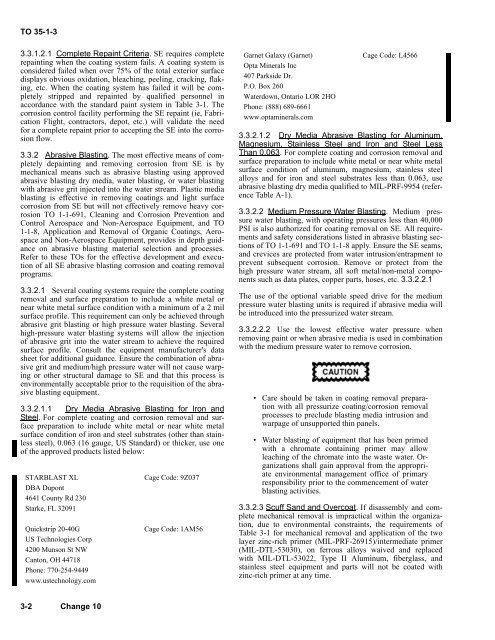TO 35-1-3 - Robins Air Force Base
TO 35-1-3 - Robins Air Force Base
TO 35-1-3 - Robins Air Force Base
Create successful ePaper yourself
Turn your PDF publications into a flip-book with our unique Google optimized e-Paper software.
<strong>TO</strong> <strong>35</strong>-1-3<br />
3.3.1.2.1 Complete Repaint Criteria. SE requires complete<br />
repainting when the coating system fails. A coating system is<br />
considered failed when over 75% of the total exterior surface<br />
displays obvious oxidation, bleaching, peeling, cracking, flaking,<br />
etc. When the coating system has failed it will be completely<br />
stripped and repainted by qualified personnel in<br />
accordance with the standard paint system in Table 3-1. The<br />
corrosion control facility performing the SE repaint (ie, Fabrication<br />
Flight, contractors, depot, etc.) will validate the need<br />
for a complete repaint prior to accepting the SE into the corrosion<br />
flow.<br />
3.3.2 Abrasive Blasting. The most effective means of completely<br />
depainting and removing corrosion from SE is by<br />
mechanical means such as abrasive blasting using approved<br />
abrasive blasting dry media, water blasting, or water blasting<br />
with abrasive grit injected into the water stream. Plastic media<br />
blasting is effective in removing coatings and light surface<br />
corrosion from SE but will not effectively remove heavy corrosion<br />
<strong>TO</strong> 1-1-691, Cleaning and Corrosion Prevention and<br />
Control Aerospace and Non-Aerospace Equipment, and <strong>TO</strong><br />
1-1-8, Application and Removal of Organic Coatings, Aerospace<br />
and Non-Aerospace Equipment, provides in depth guidance<br />
on abrasive blasting material selection and processes.<br />
Refer to these <strong>TO</strong>s for the effective development and execution<br />
of all SE abrasive blasting corrosion and coating removal<br />
programs.<br />
3.3.2.1 Several coating systems require the complete coating<br />
removal and surface preparation to include a white metal or<br />
near white metal surface condition with a minimum of a 2 mil<br />
surface profile. This requirement can only be achieved through<br />
abrasive grit blasting or high pressure water blasting. Several<br />
high-pressure water blasting systems will allow the injection<br />
of abrasive grit into the water stream to achieve the required<br />
surface profile. Consult the equipment manufacturer's data<br />
sheet for additional guidance. Ensure the combination of abrasive<br />
grit and medium/high pressure water will not cause warping<br />
or other structural damage to SE and that this process is<br />
environmentally acceptable prior to the requisition of the abrasive<br />
blasting equipment.<br />
3.3.2.1.1 Dry Media Abrasive Blasting for Iron and<br />
Steel. For complete coating and corrosion removal and surface<br />
preparation to include white metal or near white metal<br />
surface condition of iron and steel substrates (other than stainless<br />
steel), 0.063 (16 gauge, US Standard) or thicker, use one<br />
of the approved products listed below:<br />
STARBLAST XL<br />
DBA Dupont<br />
4641 County Rd 230<br />
Starke, FL 32091<br />
Quickstrip 20-40G<br />
US Technologies Corp<br />
4200 Munson St NW<br />
Canton, OH 44718<br />
Phone: 770-254-9449<br />
www.ustechnology.com<br />
Cage Code: 9Z037<br />
Cage Code: 1AM56<br />
Garnet Galaxy (Garnet)<br />
Opta Minerals Inc<br />
407 Parkside Dr.<br />
P.O. Box 260<br />
Waterdown, Ontario LOR 2HO<br />
Phone: (888) 689-6661<br />
www.optaminerals.com<br />
Cage Code: L4566<br />
3.3.2.1.2 Dry Media Abrasive Blasting for Aluminum,<br />
Magnesium, Stainless Steel and Iron and Steel Less<br />
Than 0.063. For complete coating and corrosion removal and<br />
surface preparation to include white metal or near white metal<br />
surface condition of aluminum, magnesium, stainless steel<br />
alloys and for iron and steel substrates less than 0.063, use<br />
abrasive blasting dry media qualified to MIL-PRF-9954 (reference<br />
Table A-1).<br />
3.3.2.2 Medium Pressure Water Blasting. Medium pressure<br />
water blasting, with operating pressures less than 40,000<br />
PSI is also authorized for coating removal on SE. All requirements<br />
and safety considerations listed in abrasive blasting sections<br />
of <strong>TO</strong> 1-1-691 and <strong>TO</strong> 1-1-8 apply. Ensure the SE seams,<br />
and crevices are protected from water intrusion/entrapment to<br />
prevent subsequent corrosion. Remove or protect from the<br />
high pressure water stream, all soft metal/non-metal components<br />
such as data plates, copper parts, hoses, etc. 3.3.2.2.1<br />
The use of the optional variable speed drive for the medium<br />
pressure water blasting units is required if abrasive media will<br />
be introduced into the pressurized water stream.<br />
3.3.2.2.2 Use the lowest effective water pressure when<br />
removing paint or when abrasive media is used in combination<br />
with the medium pressure water to remove corrosion.<br />
• Care should be taken in coating removal preparation<br />
with all pressurize coating/corrosion removal<br />
processes to preclude blasting media intrusion and<br />
warpage of unsupported thin panels.<br />
• Water blasting of equipment that has been primed<br />
with a chromate containing primer may allow<br />
leaching of the chromate into the waste water. Organizations<br />
shall gain approval from the appropriate<br />
environmental management office of primary<br />
responsibility prior to the commencement of water<br />
blasting activities.<br />
3.3.2.3 Scuff Sand and Overcoat. If disassembly and complete<br />
mechanical removal is impractical within the organization,<br />
due to environmental constraints, the requirements of<br />
Table 3-1 for mechanical removal and application of the two<br />
layer zinc-rich primer (MIL-PRF-26915)/intermediate primer<br />
(MIL-DTL-53030), on ferrous alloys waived and replaced<br />
with MIL-DTL-53022, Type II Aluminum, fiberglass, and<br />
stainless steel equipment and parts will not be coated with<br />
zinc-rich primer at any time.<br />
3-2 Change 10
















